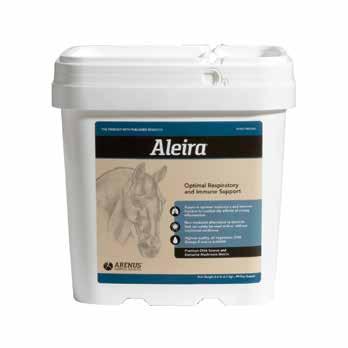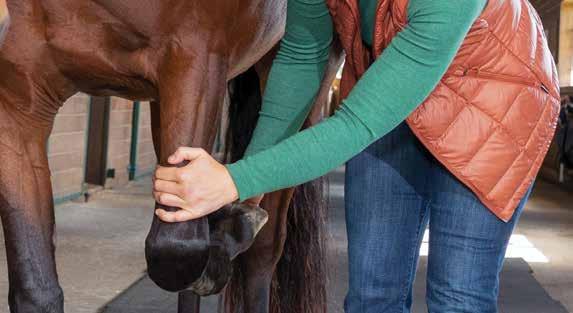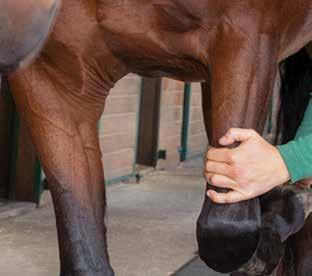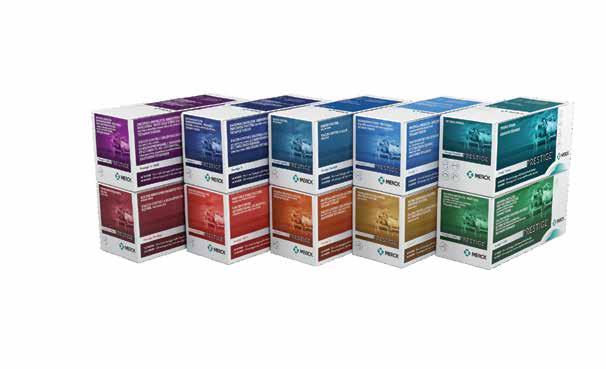Respiratory Infections & Asthma

Diet and Nonstructural Carbs
Moving to a Different Rhythm
Technician Update: The 'Liquid Rope'
Vol 13 Issue 6 2023 www.modernequinevet.com
ASK THE INFECTIOUS DISEASE EXPERT Equine Vet The Modern
SALES: ModernEquineVet@gmail.com


EDITOR: Marie Rosenthal
ART DIRECTOR: Jennifer Barlow
CONTRIBUTING WRITERS: Paul Basilio • Rob Warren

COPY EDITOR: Patty Wall
LEGAL DISCLAIMER: The content in this digital issue is for general informational purposes only. PercyBo Publishing Media LLC makes no representations or warranties of any kind about the completeness, accuracy, timeliness, reliability or suitability of any of the information, including content or advertisements, contained in any of its digital content and expressly disclaims liability of any errors or omissions that may be presented within its content. PercyBo Publishing Media LLC reserves the right to alter or correct any content without any obligations. Furthermore, PercyBo disclaims any and all liability for any direct, indirect, or other damages arising from the use or misuse of the information presented in its digital content. The views expressed in its digital content are those of sources and authors and do not necessarily reflect the opinion or policy of PercyBo. The content is for veterinary professionals. ALL RIGHTS RESERVED. Reproduction in whole or in part without permission is prohibited.
2 Issue 6/2032 | ModernEquineVet.com TABLE OF CONTENTS
Published by PERCY BO media publishing PO Box 935 • Morrisville, PA 19067 Marie Rosenthal and Jennifer Barlow, Publishers Equine Vet The Modern CARDIOLOGY Moving to a Different Rhythm 8 TECHNICIAN UPDATE Intermittent Sedation Assisted Recovery: the ‘Liquid Rope’ ............. 17 NEWS NOTES More Genes, Fewer Toes: Were Gene Copies the Key to an Evolutionary Leap for Horses? 14 Reducing HAL Risk in Insulin Dysregulation ............................................. 16 SPONSORED EDITORIAL What are the Trends in West Nile Virus Activity and the Risk to U.S. Horses? 7 Respiratory Infections May Be Risk Factor for Mild Equine Asthma COVER STORY 4 Cover: Shutterstock/Anneke Kroonder ADVERTISERS Arenus Animal Health/AssureGuard Gold 3 Merck Sponsored Editorial 7 Arenus Animal Health/Aleira-Releira 9 American Regent/Adequan 11 Merck Animal Health/Prestige 13 Dechra/Zycosan 15
THE



Arenus Animal Health | 866-791-3344 | www.arenus.com SO INNOVATIVE...
Replace your mineral oil, electrolytes, adsorbents, or other treatment options with Assure Guard Gold-NG the only effective and easy to administer slow gelling quick relief formulation including 2 cups of ultra pure psyllium, 72 billion CFU of probiotics, prebiotics, antacids, L-glutamine, electrolytes and energy. For continued support, consider a 10 day supply of Assure Guard Gold after treatment. IT’S LIKE MAGIC Ask your Arenus Veterinary Solution Specialist how Assure Guard Gold-NG and Assure Guard Gold can help your equine patients quickly and effectively recover from the digestive upsets you treat daily.
® Assure Guard
Together, Assure Guard Gold-NG And Assure Guard Gold Create A Powerhouse Against Your Most Challenging Digestive Cases. Use Assure Guard Gold-NG For Fast Relief And Maintain Excellent Digestive Health With Assure Guard Gold.
REAL MAGIC IS IN THE RESULTS
The Ultimate Digestive Aid
Gold
RESPIRATORY INFECTIONS MAY BE RISK FACTOR FOR
By Marie Rosenthal MS
Just about every veterinarian knows to look at the stable environment when diagnosing a horse for inflammatory airway disease (IAD) or mild/moderate equine asthma, but there may also be an association with certain infectious agents, according to Eric A. Richard, DVM, PhD, the head of clinical biology and senior researcher at LABÉO Frank Duncombe, in Normandy, France.
“There does appear to be some association between infection and mild equine asthma,” said Dr. Richard, although he added this is a relatively new area of research, and definitive data are lacking.

“We know the environment is involved in the occurrence of the disease, but there are fewer data about infectious agents,” he said.
Horses with mild equine asthma usually present with a history of chronic cough for at least 3 weeks, often at the beginning of training or exercise, as well as increased mucus in the trachea.
“Obviously there is inflammatory reaction; there are some allergic reactions; genetic predisposition and
maybe, the influence of several pathogenic agents in the presentation of the disease. So, it's mainly a multifactorial syndrome,” he said at the ACVIM Forum 2023, held recently in Philadelphia.
“But mild asthma is NOT an infectious disease,” he said, “The horses do not show fever or symptoms like that. We're clearly not talking about an infectious disease, but the possible influence of several pathogens in the occurrence of the disease. We are talking about risk factors.”
Although fungi, especially in the form of contaminated hay, have a clear association, the association of organisms in the airway is less so.
Bacteria
Several studies have found an association between bacteria and mild equine asthma. A longitudinal study by a group in Newmarket, England, which looked at Thoroughbreds, found Streptococcus zooepidemicus was associated significantly with an increase in tracheal mucus, but not necessarily mild equine asthma.
4 Issue 6/2022 | ModernEquineVet.com Shutterstock/ Cheryl Ann Quigley
RESPIRATORY
MILD EQUINE ASTHMA
“So, there is a significant association between the detection of Strep zoo in the trachea wash and the occurrence of increased mucus,” Dr. Richard said. “Just remember it's only detection of the bacteria in the trachea wash. We're not talking about confirmation [of disease].”
Another paper from Australia showed a significant association between the isolation of bacteria and coughing, especially when there were high counts of bacteria in the tracheal wash, but most horses did not have high bacterial counts in the tracheal wash. In those that had higher bacterial counts, they found S. zooepidemicus, S. pneumoniae, S. sanguinis, Pasteurella and Bordetella bronchiseptica.
Another study by the Newmarket group saw a significant association between several streptococcal organisms, as well as Mycoplasma and Actinobacillus with the diagnosis of equine asthma. However, the diagnosis of equine asthma was not made based on cytology of the bronchoalveolar lavage (BAL), but on mucus and trachea wash samples.
“Also, the detection of these bacteria is decreasing
with age. So, being younger than 1 year is a significant risk factor,” he said, but added, “Obviously older horses can develop asthma, too.”
Dr. Richard’s group tried to quantify the number of bacteria in horses with airway inflammation compared with controls and found no bacteria in about one-third of the tracheal wash samples of the control horses, but about 12% were positive primarily for S. zooepidemicus, Actinobacillus equuli and Pasteurella, but the bacteria count was low with about 1,000 to 4,000 CFU/mL in the control horses.
About 36% of the samples among the horses with airway disease were also sterile, and about 14% were positive for primarily for the same organisms as the control group, but the colony count was much higher with 50,000 to 10 million CFU/mL.
“There is some, I would say, strong evidence about the association between bacteria and either clinical signs and diagnosis of mild equine asthma. Please keep in mind that you know strong association does not mean causality,” he said, but more re-

ModernEquineVet.com | Issue 6/2022 5
search needs to confirm these associations.
Viruses
Viruses, however, are a little more complicated. The typical suspects for viral association would be equine herpesvirus (EHV), equine rhinitis virus (ERV), equine influenza virus (EIV), adenoviruses and coronaviruses, but the data are not as clear as they are for bacteria, Dr. Richard said.
One study found no significant relationship between mucus and cough and EHV-1 and EHV-4, EIV or adenovirus by serology.
Another study found the incidence of new cases were low, based on serology. “All those studies did not find a relationship between viral seroconversion and the onset of mild equine asthma,” Dr. Richard said.
However, in 1 study, they found the seroconversion for EHV 1 month afterward was associated significantly with mild equine asthma.
“The problem with the seroconversion is you have to sample the horse twice about 3 weeks apart to see if there's an increase in the antibody titers; the titer on 1 day is not significant, but you may have obviously some delayed response and positive association,” he said.
“So, there might be some involvement of viruses in mild asthma, even if it's not fully clear,” he said.
However, all these studies relied on serology, which is not the best methodology for detecting viral infections. Today, viruses can be detected by various types of polymerase chain reaction (PCR) tests.
“We're now able to detect viruses and to determine viral load in the sample. So, we have better tools [to gather] more relevant data for observing the association between those viruses and the occurrence of mild equine asthma,” he said.
In a retrospective study done at his laboratory about 15 years ago, using more than 700 respiratory samples from tracheal wash and BAL, they found EHV-2 to be associated significantly with the airway inflammation of the horse compared with controls.
“The detection of EHV-2 was significantly associated with the airway inflammation and abnormalities of the epithelial cells,” he said.
A longitudinal study in Sweden investigated the viral load of nasal swabs and found EHV-2 and EHV-5 were not associated with poor performance, levels of serum amyloid A, respiratory clinical signs or tracheal mucus in Standardbred horses studied over 13 months.
A case-control study done in North America among various breeds of horses with mild asthma versus controls found a significant increase in seroprevalence ERV-A and IAD. For some unknown reason ERV-A appears to be more prevalent in North America than
Europe, he said, which might influence these results.
They also detected EHV-2 in the respiratory samples of mild asthmatic horses only and not on control horses, which he found unusual because most horses have been exposed to herpes by the time they are older. His group did a prospective study in Standardbred horses and found EHV-5 by PCR in 90% of horses and EHV-2 in more than 76% of horses.
“But [in the North American study] no association was found between the different clinical signs, such as coughing and exercise intolerance and the detection of the virus. And interestingly, in this paper, cytology of BAL fluid was performed and there was no association between pulmonary function and the detection of those viruses by PCR,” he said.
His group also wanted to know whether samples taken by nasal swab were as good as those taken by tracheal wash, because there are several advantages to nasal swab samples: they are easier, faster and cheaper to do. However, his group also compared samples taken by nasal swab and tracheal wash and found “no agreement” between the samples by PCR.
“This means if you detect viral genome for any kind of virus in the nasal swabs, you have no idea if you are going to find this virus in the trachea wash. And if you find it in the trachea wash, you don't know about nasal swabs. And that's important because if there is an association between viral detection and clinical signs or mild asthma, it might also be related to the sample that has been performed.”
He did find that EHV-2 and ERV-B in the tracheal wash was significantly associated with coughing and mucus.
Fungi
Fungi in hay have been associated with mild equine asthma, but there are fewer data about fungal detection in the airways of horses with mild equine asthma. One study in Europe of more than 700 horses investigated because of poor performance detected fungi in the trachea wash in 55% of samples by culture and 79% by cytology.
“The authors found a significant association between fungal detection in trachea wash, and the diagnosis of mild equine asthma,” Dr. Richard said.
Horses that are kept on pasture rather than in stalls may be exposed less to fungal spores in hay, and so might have a lower risk for fungal respiratory disease, he said.
Various studies point of a possible association between bacterial, viruses and fungi and mild asthma, but the presence of an organism does not mean that it caused the asthma. However, it is looking more likely that the presence of infection could be a risk factor for the development of asthma. MeV
6 Issue 6/2032 | ModernEquineVet.com RESPIRATORY
ASK THE
Infectious Disease Expert
What are the trends in West Nile virus activity and the risk to U.S. horses?
The fact that West Nile virus affects horses in most of the continental United States is fairly common knowledge. What may be surprising is that data point to disease risk beginning in early spring in parts of the country not commonly considered WNV-disease hot spots.
Overall WNV-disease risk in horses is highest between July and October, but local risks are nuanced throughout the year, according to one of the largest studies investigating WNV-risk for horses (Humphries et al 2021). Beginning in May, horses in the North and West face the highest risk of WNV illness. Cases increase in this region through June, when risk begins to ramp up in the South, then spreads homogenously across the country through September when total cases peak. Through fall and winter, most disease occurs in southern coastal states with continued warm, humid weather.
DROUGHT MIGHT NOT DRY UP DISEASE
Our growing understanding of how precipitation—or the lack thereof—affects WNV might explain why states with moderate rainfall or even drought can have high annual incidence of WNV-disease in horses. Low levels of rain or drought do appear to suppress disease risk, but moderate and severe drought can increase disease transmission. During drought, mosquitoes, birds and horses cluster at the same water source, allowing for spillover of disease into hors-
ABOUT THE AUTHOR
HORSES IN THESE AREAS
EXPERIENCE HIGH WNV-DISEASE RISK YEAR AFTER YEAR:
BOOSTING MARE/FOAL PROTECTION
Multiple boosters a year are especially important for young horses that may not have a long history of repeated vaccinations. In foals, given the unpredictability of WNV, give three injections to account for waning maternal immunity. Administer the first dose at 4 to 6 months of age, followed in 3 to 4 weeks (per label) with a booster. Give another booster at least 8 weeks later. Owners can experience ‘vaccination fatigue’ after a long foaling season, and weanlings are especially at risk for missing that last booster due to changes in management.
es. When rain falls after dry conditions in Midwestern and Northern climates, standing water can exacerbate mosquito activity. Conversely, torrential rains in the South can wash out WNV-carrying mosquitoes, diminishing disease risk to horses.
EARLIER SEASON, EARLIER VACCINATION
What do these trends mean for your equine patients? The timing of WNV vaccination may need to be adjusted and careful documentation of vaccine history is essential for virtually all locations in the U.S. For instance, even in Northern and Midwestern climates, consider administering WNV vaccinations in early spring, well before May and perhaps while snowfall is still possible. In Southern states with year-round risk, horses may need additional WNV boosters as activity increases in the fall.
Yearling horses must receive their first annual vaccination no later than March to maintain protection obtained as a weanling. Owners are often under the mistaken impression that these horses will be protected for a full year after the third booster, which is often administered in early fall. Thus they may skip another closely timed injection the following spring. Any yearling with questionable vaccine history as a foal should undergo a full series of two injections in the spring. All pregnant mares should be vaccinated in late gestation to achieve high levels of colostral antibody.
Remember WNV is a nationwide disease that affects different areas of the country at various times throughout the year. If interested in a specific location, the CDC provides the most reliable indication of real-time WNV activity because it includes mosquito, sentinel, horse and human activity. Access it at https://www. cdc.gov/westnile/statsmaps/index.html
WANT TO ASK A QUESTION?
Maureen T. Long, DVM, PhD, DACVIM (large animal), is a professor in the Department of Comparative, Diagnostic & Population Medicine at the University of Florida College of Veterinary Medicine. She has written and edited several hundred research papers and educational publications, such as the reference book, Equine Infectious Diseases.

EMAIL THE EDITOR.
For more information on vaccination against WNV, visit the Merck Animal Health Prestige® 5 + WNV vaccine page.
This column, brought to you by Merck Animal Health, features insightful answers from leading minds.
Copyright © 2023 Merck & Co., Inc., Rahway, NJ, USA and its affiliates. All rights reserved.
ModernEquineVet.com | Issue 6/2023 7
Eastern
Coastal
West
Northwest
Central
Eastern
Central
Central Pennsylvania
Iowa
South Atlantic States
Texas
Minnesota
Montana
Washington
Gulf coast Idaho-Oregon
border Single-county hotspots occur in isolated areas in Colorado, North Dakota and California
Moving to a
Different Rhythm
When Rio, an 8-year-old American Quarter Horse gelding, was diagnosed with atrial fibrillation (AFib), Alana Alpern, DVM, took him to her alma mater, the UC Davis School of Veterinary Medicine.

When Dr. Alpern was a student at UC Davis more than 15 years ago, the school was one of the few places in the United States performing transvenous electrical cardioversion (TVEC). Since Dr. Alpern graduated in 2007, the school has performed only a handful of TVEC procedures, due to a lack of essential equipment over the past decade.

“It’s been a long time since we’ve performed a TVEC at UC Davis,” said Jessica Morgan, DVM, of
the Equine Field Service. “But I gained a lot of experience with them in my time as a clinician at the University of Pennsylvania, so we have the right team and equipment to offer that option again.”
Dr. Morgan consulted with Fiona Wensley, DVM, in the Equine Medicine Service treating Rio, the Cardiology Service, and the Anesthesia Service—as well as Dr. Alpern—about the possibility of a TVEC being an option for Rio, after quinidine, a medication commonly used for cardioversion failed to correct his arrhythmia, according to Dr. Morgan.
“Dr. Alpern was looking for an opportunity to try something else, and we agreed that a TVEC was the
CARDIOLOGY
8 Issue 6/2032 | ModernEquineVet.com Image courtesy of UC
Davis
Rio is doing well
Electrodes on the tips of catheters were placed in Rio's chest to perform the TVEC procedure.



answer,” Dr. Morgan said.
A cutaneous method—placing electrode paddles on the chest— is the preferred way to perform an electrical cardioversion on dogs and people, but a horse’s large muscle mass does not allow the shock wave to reach the heart without causing deadly complications. Veterinarians must approach the horse’s heart with electrodes on the tips of catheters placed across the heart through the horse’s veins.
Electrodes on the tips of catheters were placed in Rio's chest to perform the TVEC procedure.
Two catheters were placed in Rio’s right jugular vein–one was advanced into the left pulmonary artery and the other into the right atrium. Their positions were placed with the assistance of echocardiography and confirmed with radiographs of his chest.
Rio was then anesthetized, and a shock wave produced by a life pack was sent to the electrodes with the intention of stunning the atrium, then allowing it to restart.
The procedure was successful, and Rio’s heart was shocked back into a normal sinus rhythm, confirmed by a post-procedure electrocardiogram. A follow-up echocardiogram several days later revealed improvement of previous findings.

“From a cardiovascular standpoint, Rio has a good prognosis for return to athletic function, as long as he is able to maintain sinus rhythm,” Dr. Morgan said. “He didn’t have any major complications with the procedure, and he hasn’t gone back into atrial fibrillation.”
Rio was placed on medication to reduce the risk
CARDIOLOGY 10 Issue 6/2022 | ModernEquineVet.com
TVEC to shock a horse's heart back to a normal rhythm has come back to universities on both sides of the country.
Image courtesy of UC Davis
The many people involved in Rio's cardiovascular procedure.
nothing else like it.
For more than 30 years, Adequan® i.m. (polysulfated glycosaminoglycan) has been administered millions of times1 to treat degenerative joint disease, and with good reason. From day one, it’s been the only FDA-Approved equine PSGAG joint treatment available, and the only one proven to.2, 3
Reduce inflammation
Restore synovial joint lubrication
Repair joint cartilage
Reverse the disease cycle
When you start with it early and stay with it as needed, horses may enjoy greater mobility over a lifetime.2, 4, 5 Discover if Adequan is the right choice. Visit adequan.com/Ordering-Information to find a distributor and place an order today.

BRIEF SUMMARY: Prior to use please consult the product insert, a summary of which follows: CAUTION: Federal law restricts this drug to use by or on the order of a licensed veterinarian. INDICATIONS: Adequan® i.m. is recommended for the intramuscular treatment of non-infectious degenerative and/or traumatic joint dysfunction and associated lameness of the carpal and hock joints in horses. CONTRAINDICATIONS: There are no known contraindications to the use of intramuscular Polysulfated Glycosaminoglycan. WARNINGS: Do not use in horses intended for human consumption. Not for use in humans. Keep this and all medications out of the reach of children. PRECAUTIONS: The safe use of Adequan® i.m. in horses used for breeding purposes, during pregnancy, or in lactating mares has not been evaluated. For customer care, or to obtain product information, visit www.adequan.com. To report an adverse event please contact American Regent, Inc. at 1-888-354-4857 or email pv@americanregent.com.
Please see Full Prescribing Information at www.adequan.com
1 Data on file.
2 Adequan® i.m. Package Insert, Rev 1/19.
3 Burba DJ, Collier MA, DeBault LE, Hanson-Painton O, Thompson HC, Holder CL: In vivo kinetic study on uptake and distribution of intramuscular tritium-labeled polysulfated glycosaminoglycan in equine body fluid compartments and articular cartilage in an osteochondral defect model. J Equine Vet Sci 1993; 13: 696-703.

4 Kim DY, Taylor HW, Moore RM, Paulsen DB, Cho DY. Articular chondrocyte apoptosis in equine osteoarthritis. The Veterinary Journal 2003; 166: 52-57.
5 McIlwraith CW, Frisbie DD, Kawcak CE, van Weeren PR. Joint Disease in the Horse.St. Louis, MO: Elsevier, 2016; 33-48.
All trademarks are the property of American Regent, Inc.
© 2021, American Regent, Inc.
PP-AI-US-0629 05/2021
There’s
www.adequan.com
of recurrence, and Dr. Alpern has a cell-phone-based electrocardiogram unit to monitor him at home.
After 2 months, Dr. Alpern reports that Rio is doing well and is back to giving short rides to her children. She remains optimistic about his recovery.
TVEC on the East Coast TVEC was also used recently at Cornell University College of Veterinary Medicine, in New York.
Rose, a 9-year-old Warmblood mare, had just the right amount of energy and feistiness to become a successful show jumper when her owner, Claudia, bought her in January 2022.
But 9 months later at a series of classes in Tryon, N.C., Claudia noticed a change. While Rose had initially performed well, during the last class she began knocking fences down. When they left the ring, Rose developed a nosebleed.
And while 3 other horses developed nosebleeds that day, Sarah Allendorf, DVM, the veterinarian on site, noticed something additional in Rose. She had an arrhythmia.
Claudia and her horses traveled home to Cazenovia, N.Y., and a few weeks later, Rose’s heart still had not improved. Claudia set up an evaluation at the Cornell Equine and Nemo Farm Animal Hospitals (ENFAH), where Katharyn Mitchell, DVM, assistant professor in the Section of Large Animal Medicine with a subspecialty in cardiology, reviewed Rose’s case and had suspicions of AFib.
Because Rose’s heart had not spontaneously returned to sinus rhythm, Dr. Mitchell, with Beth Williams Louie, DVM, and Hanna Sfraga, a resident in large animal medicine, evaluated Rose to determine the cause of the AFib.
“While AFib can be a secondary condition that’s caused by underlying heart disease, bigger horses like Rose are more at risk for arrhythmias simply due to their size and their naturally larger hearts,” Dr. Mitchell said.
Rose’s evaluation involved multiple components, including an echocardiography, exercise test at the walk, trot and canter while Rose wore a portable ECG device that transmits to a computer so the heart rate and rhythm can be monitored in real time.
Although the evaluation ruled out underlying cardiac disease, Dr. Mitchell found that Rose expe-
rienced tachycardia during exercise, making it dangerous for Rose to do so.
Based on Rose’s risk factors and tachycardia, Dr. Mitchell and her team decided to perform TVEC, which also just returned to Cornell.
For the procedure, Dr. Mitchell and other members of the ENFAH Cardiology Service guided catheters to the heart while Rose was standing and lightly sedated. Starting from the right jugular vein, the specially designed long catheters pass into the right atrium, right ventricle and pulmonary artery. The correct placement was evaluated in real time using ultrasonography, and then once again with a radiograph taken by the Imaging Service.
Then, the Anesthesia and Pain Medicine Service induced general anesthesia and monitored Rose’s health status so Dr. Mitchell and her team could watch the ECG and time the TVEC shocks appropriately. The TVEC stops the arrhythmia, giving Rose’s heart a chance to resume a normal sinus rhythm. It took 4 shocks for Rose’s heart to do so, which Dr. Mitchell says is average for this procedure.
Rose recovered from the anesthesia and TVEC well. She rested for 1 month and a recheck at Cornell showed good results. Claudia started jumping Rose, working with her incrementally to ensure she wasn’t doing too much too quickly.
6 months after the procedure, Rose was back to jumping nearly as high as she was prior to the AFib diagnosis.
Because she’s a bigger horse with a naturally larger heart, she has a risk of another AFib recurrence, but other factors are in her favor. Because of Dr. Allendorf’s quick diagnosis and Claudia’s rapid contact with Cornell, she was not in AFib for very long prior to her procedure, and she has not had any other known AFib episodes.
Both horses are doing well. MeV
The report is a combination of 2 reports on the UC Davis and Cornell University websites. The originals were written by Rob Warren (UC Davis) and Jamie Crow (Cornell). You can find the originals here: https://www. vetmed.ucdavis.edu/news/electrical-shock-procedurecorrects-horses-irregular-heartbeat and https://www. vet.cornell.edu/news/20230614/cornell-helps-horseirregular-heartbeat-return-jumping
12 Issue 6/2032 | ModernEquineVet.com
CARDIOLOGY
For Rose's procedure, they guided catheters to the heart while Rose was standing and lightly sedated.


Talk to your Merck Animal Health representative today to learn more about the PRESTIGE® line of vaccines or visit PrestigeVaccines.com Copyright © 2022 Merck & Co., Inc., Rahway, NJ, USA and its affiliates. All rights reserved. 1 Data on file. Merck Animal Health. Trust PRESTIGE® vaccines —the spectrum of essential disease protection. Flexibility by Design Multiple antigen combinations make creating custom programs easy Proven Safety and Efficacy Shown to be 98% reaction-free in field safety trials1 People and Programs That Make a Difference Merck Animal Health industry support and dedication to equine welfare included in every dose
The True Colors of Vaccine Performance
More Genes, Fewer Toes: Were Gene Copies the Key to an Evolutionary Leap for Horses?
By Amy Young
Eighteen million years ago, a genetic duplication event coincided with the evolutionary split between horses and their four-toed, forest-browsing ancestors.

A recent study by Danika Bannasch, PhD, and Kevin Batcher, a PhD student in her lab, investigated specific genetic duplications in horses, finding evidence of important roles for these elements and countering historical conventions that they have no function.
A certain class of genetic variation in animals are caused by an element called LINE-1 (long interspersed nuclear element 1), which is still active and capable of
making new copies of itself and sometimes copies of other genes, called retrocopies. The study investigated these extra gene copies in horses and other domestic and wild equids. Of the 437 retrocopies identified, only 5 were shared between horses and other equids, indicating that most of the extra copies formed after the species experienced an evolutionary split.
A retrocopy of the gene Ligand Dependent Nuclear Receptor Corepressor Like (LCORL) was present in all equids (horses, donkeys, zebras) but absent from other species of odd-toed ungulates alive today, such as rhinoceroses and tapirs. This retrocopy was also duplicated many times within equids, with the majority of LCORL tissue expression in horses and donkeys originating from these retrocopies rather than the parent gene. Dr. Bannasch said the LCORL was an exciting gene to identify since it is a major body-size gene across mammals.
The original retrocopy, estimated to have occurred 18 million years ago, happened during the period when equids experienced an increase in body size, a reduction in the number of toes, and changes in their teeth. The age of the LCORL retrocopy and the large number of expressed LCORL retrocopies in today’s equids provide evidence of their function in equid evolution.
“The results of this study, along with results reported in other species, imply important roles for these retrocopies,” said Dr. Bannasch who serves as the Maxine Adler Chair in Genetics at the UC Davis School of Veterinary Medicine. “Future studies may uncover additional evolutionary links, as well as implications for health in horses and other animals.”
MeV
This story was originally published on the UC Davis website. It is used with permission and edited for style. https://www.vetmed.ucdavis.edu/news/more-genes-fewer-toes-were-gene-copies-key-evolutionary-leap-horses
14 Issue 6/2032 | ModernEquineVet.com
NEWS NOTES Batcher K, Varney S, Raudsepp T, et al. Ancient segmentally duplicated LCORL retrocopies in equids PLOS one 2023 June 8. https://doi. org/10.1371/journal.pone.0286861 https://journals.plos.org/plosone/article?id=10.1371/journal.pone.0286861 For more information:
Break free
Help your equine patients by controlling the clinical signs associated with osteoarthritis

• The only FDA approved pentosan polysulfate sodium injection
• Convenient; only 4 intramuscular injections required
• Not limited to use for specific joints1
To learn more about Zycosan®, please scan the QR code or visit go.dechra-us.com/zycosan

24-hour Veterinary Technical Support available: (866) 933-2472
Nonurgent Technical Support available: support@dechra.com
Important Satefy Information
As with all drugs, side effects may occur. For intramuscular use in horses only. Not for use in humans. Pentosan polysulfate sodium is a weak anticoagulant. Caution should be used when administering Zycosan if you are taking an anticoagulant. In case of accidental self-injection, seek immediate medical attention. If product comes into contact with skin, rinse skin thoroughly with water and seek medical attention if needed. Horses with hypersensitivity to pentosan polysulfate sodium should not receive Zycosan. Do not use Zycosan concurrently with other anticoagulant drugs. Do not use in horses with clotting disorders or within 24 hours of surgical procedures. Caution should be used when administering this drug before or after strenuous activities. Caution should be used when NSAIDS are administered concurrently due to the anticoagulant effects of Zycosan. If Zycosan and NSAIDS are used concurrently, horses should be monitored for hemorrhage or other clinical signs of abnormal bleeding. The safe use of Zycosan has not been evaluated in breeding, pregnant, or lactating horses. The safety of long-term repeat use of Zycosan has not been evaluated. The most frequently reported adverse reactions are injection site reactions, prolongation of coagulation parameters (activated partial thromboplastin time (aPTT) and prothrombin time (PT). Refer to the prescribing information for complete details or visit www.dechra-us.com.
1. Zycosan® Freedom of Information Summary NADA 141-559 © 2023 Dechra Veterinary Products. Dechra is a registered trademark of Dechra Pharmaceuticals PLC. Zycosan is a registered trademark of Dechra Limited; all rights reserved. E230047
Reducing HAL Risk in Insulin Dysregulation
Limiting pure starch and sugar sources in horses with insulin dysregulation might reduce the risk of hyperinsulinemia-associated laminitis (HAL).
Researchers wanted to identify the levels of nonstructural carbohydrates (NSC) that could limit the postprandial insulinemic response in the insulin dysregulated horse. They conducted a crossover study to determine if there were thresholds for pure sources of starch and sugar that augmented the insulin response in horses with insulin dysregulation.
They randomly fed 14 adult horses—6 with insulin dysregulation and 8 without—8 different diets that had various amounts of starch and sugar. The horses were similar in weight. Dietary treatments were formulated using a base of low-nonstructural carbohydrate pellet which contained differing amounts of additional dex-
For more information:
https://beva.onlinelibrary.wiley.com/doi/10.1111/evj.13910
Zycosan®
(pentosan polysulfate sodium injection)
250 mg/mL
For intramuscular use in horses only.
Brief Summary (For Full Prescribing Information, see package insert)
CAUTION: Federal law restricts this drug to use by or on the order of a licensed veterinarian.
DESCRIPTION: Zycosan contains pentosan polysulfate sodium, a semi-synthetic polysulfated xylan. It is a pale yellow to brownish yellow, clear, sterile solution.
INDICATION: For the control of clinical signs associated with osteoarthritis in horses.
CONTRAINDICATIONS: Horses with hypersensitivity to pentosan polysulfate sodium or any of the inactive ingredients in Zycosan should not receive Zycosan. Do not use Zycosan concurrently with other anticoagulant drugs. Do not use in horses with clotting disorders or within 24 hours of surgical procedures (see Warnings and Precautions).
WARNINGS AND PRECAUTIONS:
User Safety Warnings: Not for use in humans. Keep out of reach of children. Pentosan polysulfate sodium is a weak anticoagulant. Caution should be used when administering Zycosan if you are taking an anticoagulant. In case of accidental self-injection, seek immediate medical attention. If product comes into contact with skin, rinse skin thoroughly with water and seek medical attention if needed. To obtain a Safety Data Sheet (SDS), contact Dechra at (866) 933-2472.
Animal Safety Warnings and Precautions: Zycosan has been shown to prolong coagulation parameters up to 24 hours after injection, therefore caution should be used when administering this drug before or after strenuous activities (see Target Animal Safety). Due to the anticoagulant effects, this drug may exacerbate Exercise Induced Pulmonary Hemorrhage (EIPH).
trose or waxy-maize and oat-starch powder.
Horses were fed each dietary treatment at a rate of 1 g/kg body weight (bwt) once over 12 weeks. Serial blood samples were collected pre- and up to 240 minutes post-prandially, and positive incremental area under the curve for insulin (IAUCi) was calculated for each horse.
Among the horses without insulin dysregulation, the diets had no significant effect on IAUCi. However, the horses with insulin dysregulation had an increased IAUCi for diets between 0.07–0.13 g of total NSC/kg bwt, depending on the starch and sugar composition.
Horses with insulin dysregulation appear to have a threshold for NSCs of about 0.1 g/kg bwt per meal. Higher levels increase the insulin responses of the horses and put them at higher risk for HAL. MeV
The concurrent use of NSAIDs with Zycosan has not been evaluated. Due to the anticoagulant effects of Zycosan and known anticoagulant effects of some NSAIDs, caution should be used if NSAIDs are concurrently administered. Horses concurrently treated with Zycosan and NSAIDs should be monitored for hemorrhage or other clinical signs of abnormal bleeding (e.g., petechiae, ecchymosis, or epistaxis). The safety of long-term repeat use of Zycosan has not been evaluated. Pigmentary changes in the retina (pigmentary maculopathy) have been reported in human patients following long-term oral use of pentosan polysulfate sodium. It is not known if a similar finding occurs in horses. The safe use of Zycosan has not been evaluated in breeding, pregnant, or lactating horses.
Other Warnings: Do not use in horses intended for human consumption.
ADVERSE REACTIONS:
Injection site reactions were the most frequently reported adverse reactions in the field study. Injection site reactions were associated with clinicopathology changes in some cases. Other adverse reactions reported in more than one horse were prolongation of coagulation parameters (activated partial thromboplastin time (aPTT) and prothrombin time (PT)), lethargy, behavior changes, and colic. To report suspected adverse events, for technical assistance or to obtain a copy of the Safety Data Sheet (SDS), contact Dechra at (866) 933-2472 . For additional information about adverse drug experience reporting for animal drugs, contact FDA at 1-888-FDA-VETS or online at http://www.fda.gov/reportanimalae.
STORAGE CONDITIONS: Store at room temperature 68-77°F (20-25°C), with excursions to 59-86°F (15-30°C).
MANUFACTURED FOR:
Dechra Veterinary Products
7015 College Boulevard, Suite 525
Overland Park, KS 66211 USA
Approved by FDA under NADA # 141-559
Zycosan is a trademark of Dechra Limited.
R 01 2023
NEWS NOTES
Macon EL, Harris P, Bailey, et al. Identifying possible thresholds for nonstructural carbohydrates in the insulin dysregulated horse. Equine Vet J. 2022 Dec. 20 https://doi.org/10.1111/evj.13910
Intermittent Sedation-Assisted Recovery; the ‘Liquid Rope’
By Travis Otremba, LVT,CVT
Recovering horses from inhalant anesthesia can be a challenge. Horses are, in general, large and can become quite uncoordinated as they arouse from anesthesia.



The anesthetics we use have an affinity for fat and muscle, and many horses can have plenty of both. Compounding matters, those anesthetic agents cause emergent delirium, hallucinations and dissociative behaviors in the horse. Add in a tight sympathetic tone, with a fightor-flight response that is almost always engaged, and you have a recipe for a potential train-wreck recovery.
In cases where recovery carries an increased risk, rope-recoveries are common. A head and tail rope, with 2 assistants, 1 on each respective rope, help the horse to steady itself once aroused and attempting to stand. The rope-recovery limits the “free” movement of the horse within the recovery stall, thus decreasing the risk of injury.
However, what happens when staffing is at a shortage, and there aren’t any extra bodies to help you recover the patient? Or, you might not have ropes or the setup to use them properly. What if the horse will not tolerate being tied to the wall? Or will it panic when it realizes there is a rope tied on its tail?
When these challenges arise, I turn to the “liquid rope” recovery; a 1-individual, intermittent sedationassisted recovery that can help to ensure a quiet and low-risk standing from general anesthesia.
At Ocala Equine Hospital, we have a heavy and fast-paced orthopedic case load. Ensuring a good and efficient recovery from anesthesia is paramount to our success. Often, horses just need a little extra help other than a free, unassisted recovery but may not require or tolerate an actual rope recovery.
It’s for these patients that the intermittent sedation recovery method works well.
The protocol is similar in technique to a rope recovery, i.e., the horse is positioned on a pad, back to the doors, the anesthetist directly behind the withers and a towel covers the eye. The extension-set from the IVC is draped over so the anesthetist can access it easily.
Everything about this set up is almost identical to
a rope recovery, there is just 1 caveat: no ropes, and it only uses 1 person; no second assistant needed.
Chemical restraint now replaces any physical restraint, and the anesthetist relies on intermittent sedation. By intermittent sedation, I mean small boluses of a sedative (almost always xylazine due to its fast-acting

ModernEquineVet.com | Issue 6/2023 17 TECHNICIAN UPDATE
Images courtesy of Travis Otremba
The liquid rope enables the horse to clear itself of the anesthesia used during surgery and awaken more calmly, reducing its risk for injury.
Teaching Points
The main goal of intermittent sedation is to delay arousal to give the horse time to burn off the anesthetics given during surgery before it returns to consciousness.
You might find that 1 bolus sends them deeper or multiple bumps within a short time might be needed to keep them unconscious. By keeping the bumps of sedation small, the anesthetist can add more if warranted, but not start to accumulate a lot of xylazine in the horse. Experience will help in differentiating the subtle changes that clue you in that arousal is coming, but staying alert to the horse and having a plan is necessary to success.
and fast-clearing properties), given at specific increments during the recovery phase.
I like to split the timing of this sedation into 3 different areas:
1. pre-arousal,
2. arousal and
3. standing.
Since there is no physical restraint being applied to the horse, i.e. no halter, ropes or humans to lay on it, I tend to give most of my sedation boluses during the prearousal phase. The goal is to delay arousal in this phase. As I stated before, horses can arouse very uncoordinated, fractious and panicked.
To decrease that chance, I prefer to delay their arousal and give them a chance to blow off a lot of the inhalant. When I see my horses coming back to consciousness around the 15-minute mark, I will delay that to about 30–40 minutes post end of inhalant anesthesia.
To do this, a fast-acting but short-living alpha-2 sedative works well and that is why I use xylazine, almost exclusively. Alpha-2 sedatives are potentiated by inhalants, so understanding that relationship gives the anesthetist an edge to keep them down without overdosing. Small boluses can really go a long way to keeping the horse unconscious while still breathing off the excess gas, creating a clearer animal once it wakes up.
Once the horse is positioned on the mat in recovery, I like to give the first small bolus of xylazine, just before removing the endotracheal tube. If they are still fairly deep with inhalant, this could cause a small bout of apnea, but
if not, it will facilitate a stimulant-free extubation and not arouse the horse. At this point, the horse is positioned, extubated and breathing well.
As the horse comes up the levels of unconsciousness, take note of breathing patterns, light sensitivity in the eye and any tensing of the horse. Small boluses of xylazine may be administered as changes in respiration occurs or light sensitivity in the eye starts to return. Generally, around every 8–10 minutes a small bolus of xylazine is given.
If there is some early tensing in the neck or limbs, a larger dose might be advantageous as you might be getting a bit too close to arousal.
As the horse slowly comes up to consciousness, ear movement is a fairly consistent sign that the horse is back to consciousness and is responding to its environment. However, any leg movement, neck movement, or swallowing should be treated as arousal.
This is one of the most important doses, in my opinion, as it slows the horse’s panic or abolishes the emergent delirium caused by inhalant anesthesia. Since the arousal has been delayed, and the horse has had time to breathe off anesthetics, there is no longer a significant amount of inhalant within the horse to potentiate a small bump of xylazine, so a larger dose is generally warranted.
As well, I tend to talk to them in a low, soothing voice and pet their neck as they are returning to consciousness, giving them some calming encouragement. Horses are social animals, and many will respond positively to the calm voice.
The towel is still over the eye, and as long as the horse is quiet I may remove it, but I’ll leave it on if the animal is significantly light sensitive or wants to move. On the chance the horse immediately rolls to sternal and has an abrupt arousal, a bump of xylazine should help to quiet the ‘flight’ reflex, and a lot of times the horse will lay back to a semi-sternal recumbency, or stand strong and quick.
On average, they should have the appearance of lighter sedation, not so much so their nose is on the floor.
Soon, the horse should be standing. It may be tempting to encourage the horse to stand at this time, but resist that urge and allow them the time to wake up quietly on their own and without pressure.
Again, talking to them during this stage is a great tool to help keep them calm. Once the horse makes the effort to stand, be prepared to leave the stall and close it up. The horse should be quiet, slightly sedate but alert. Keep in mind, a small amount of stored drug in the muscle or fat may get squeezed into circulation due to the sudden engagement of muscles.
Nystagmus, muscle twitching and a ‘stunned’ appearance may be seen.
18 Issue 6/2032 | ModernEquineVet.com TECHNICIAN UPDATE
Shutterstock/nelelena
Once they are standing, however, that will diminish quickly and within a few minutes the horse should appear normal. Having the stall ready to be shut up, though, is important for safety for everyone—including the horse—in case they go down or have a harder recovery.
Once standing, if they are a bit wound up or need more pain management, a small amount of butorphanol or detomidine may be beneficial to quiet them again and give the anesthetist time to get the horse organized before heading back to their stall.
In all, this recovery works well to get a horse from general anesthetic recumbency to standing, when there is increased risk to the surgery site, or the patient presents a risk to themselves by allowing a free recovery.
By delaying arousal, quieting the flight response and keeping them calm, the intermittent-sedation-assisted recovery method is useful for anesthetists in equine surgery to get their horses standing. Furthermore, as a 1-person
For more information:
recovery, it is easily incorporated in a variety of practices to ensure a high standard of care for the horse. MeV

About the Author
Born and raised in Michigan, Travis graduated from Baker College, Jackson, and obtained his credentials as a licensed veterinary technician. Travis worked for 8 years as a small-animal technician in general practice, as well as a short time in surgical oncology in his home state. Following his passion for horses, Travis made the move to Ocala, Fla., in 2014, to work for Ocala Equine Hospital. With a focus solely on anesthesia, he completed a 4-month mentorship with Eric Abrahamsen, DVM, DACVAA, and became a surgery technician, anesthesia. Since then, he has been credentialed in Florida as a certified veterinary technician.
ModernEquineVet.com | Issue 6/2023 19
AAEVT Equine Manual for Veterinary Technicians, DeNotta, S, et.al. Wiley Blackwell, 2023. Enhanced Chemical Restraint, Abrahamsen, EJ, DVM,DACVA. 2014.
MODERNEQUINEVET.COM CHECK OUT OUR NEW WEBSITE Equine Vet The Modern

Reach your veterinarians wherever they are, whenever they want. FOR ADVERTISING RATES AND INFORMATION, EMAIL ModernEquineVet@gmail.com Equine Vet The Modern CHECK OUT OUR NEW WEBSITE AT www.modernequinevet.com

































